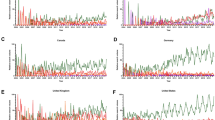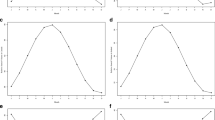Abstract
Background
Internet searches are an increasingly used tool in medical research. To date, no studies have examined Google search data in relation to common gastrointestinal symptoms.
Aims
The aim of this study was to compare trends in Internet search volume with clinical datasets for common gastrointestinal symptoms.
Methods
Using Google Trends, we recorded relative changes in volume of searches related to dysphagia, vomiting, and diarrhea in the USA between January 2008 and January 2011. We queried the National Inpatient Sample (NIS) and the National Hospital Ambulatory Medical Care Survey (NHAMCS) during this time period and identified cases related to these symptoms. We assessed the correlation between Google Trends and these two clinical datasets, as well as examined seasonal variation trends.
Results
Changes to Google search volume for all three symptoms correlated significantly with changes to NIS output (dysphagia: r = 0.5, P = 0.002; diarrhea: r = 0.79, P < 0.001; vomiting: r = 0.76, P < 0.001). Both Google and NIS data showed that the prevalence of all three symptoms rose during the time period studied. On the other hand, the NHAMCS data trends during this time period did not correlate well with either the NIS or the Google data for any of the three symptoms studied. Both the NIS and Google data showed modest seasonal variation.
Conclusions
Changes to the population burden of chronic GI symptoms may be tracked by monitoring changes to Google search engine query volume over time. These data demonstrate that the prevalence of common GI symptoms is rising over time.


Similar content being viewed by others
References
Nuti SV, Wayda B, Ranasinghe I, et al. The use of google trends in health care research: a systematic review. PLoS One. 2014;9:e109583.
Monthly US Search Engine Rankings. 2015. http://www.comscore.com/Insights/Market-Rankings/comScore-Releases-August-2015-U.S.-Desktop-Search-Engine-Rankings. Accessed 01 June 2016.
Ginsberg J, Mohebbi MH, Patel RS, et al. Detecting influenza epidemics using search engine query data. Nature. 2009;457:1012–1014.
Breyer BN, Sen S, Aaronson DS, et al. Use of Google Insights for Search to track seasonal and geographic kidney stone incidence in the United States. Urology. 2011;78:267–271.
Breyer BN, Eisenberg ML. Use of Google in study of noninfectious medical conditions. Epidemiology. 2010;21:584–585.
Gunn JF 3rd, Lester D. Using google searches on the internet to monitor suicidal behavior. J Affect Disord. 2013;148:411–412.
Peery AF, Dellon ES, Lund J, et al. Burden of gastrointestinal disease in the United States: 2012 update. Gastroenterology. 2012;143:1179-87.e-1–1179-87.e-3.
Grant Support
UCSF-CTSI Grant No. UL1 TR000004. Support also provided by the Alafi Foundation.
Author information
Authors and Affiliations
Corresponding author
Ethics declarations
Conflict of interest
None.
Rights and permissions
About this article
Cite this article
Hassid, B.G., Day, L.W., Awad, M.A. et al. Using Search Engine Query Data to Explore the Epidemiology of Common Gastrointestinal Symptoms. Dig Dis Sci 62, 588–592 (2017). https://doi.org/10.1007/s10620-016-4384-y
Received:
Accepted:
Published:
Issue Date:
DOI: https://doi.org/10.1007/s10620-016-4384-y




